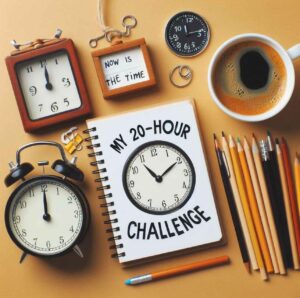Welcome Blessings!
(Tap 🔽 to see more topics!)


Imagine being able to learn anything faster, using the 20-hour rule, to effortlessly pick up new skills that once seemed out of reach. This isn’t some far-off dream. It’s a real possibility and not about having a secret superpower. Do you know those people who seem to master new things with surprising speed? Playing an instrument, coding, or speaking a new language? They haven’t stumbled upon magic. They’ve discovered a more effective way to learn, and today, you’re about to discover that same approach for yourself.
Forget the outdated notion that becoming proficient in something new requires an endless 10,000 hours. Sure, reaching the pinnacle of any field demands a lifetime of dedication. However, to become competent, to gain enough skill to enjoy and utilize a new ability genuinely, or even express yourself to a few people along the way – the timeline shrinks dramatically. We’re talking about roughly 20 focused hours of the right kind of practice. Sounds like magic, right?
Today, we’ll unpack the power of this “20-Hour Rule.” We’ll discuss its mechanics, the research supporting its effectiveness, and, most importantly, practical ways you can start implementing it this week to open up a world of new possibilities.
You know that famous idea floating around, the “10,000-hour rule“? It became super popular thanks to Malcolm Gladwell. The gist was that if you wanted to become a true master at something, like a concert violinist or a chess grandmaster, you needed to put in around 10,000 hours of really focused practice.
But okay, here is where things get interesting and where many people get the wrong idea. That 10,000-hour mark? It’s all about reaching the absolute peak. We’re talking about the kind of skill that puts you in the top tiny percentage of people in the world.
This is where the “20-Hour Rule” steps in, and honestly, it can completely change how you think about learning. If becoming a master is like scaling Mount Everest – an enormous undertaking requiring specialized gear and tons of experience – then becoming good enough is like taking a fantastic hike up a local trail. You still get to enjoy an incredible view and the satisfaction of reaching the top without needing all that extreme preparation and commitment.
Okay, let’s leave the Everest climbing to the professionals for now. We’re here to talk about those excellent local hikes that are way more accessible and just as rewarding.

What’s all this buzz about the “20-Hour Rule”? Well, a smart guy named Josh Kaufman put it on the map with his popular TEDx talk and a book called “The First 20 Hours.” Honestly, the core idea is super straightforward. You can learn the basics of anything quickly. We’re talking about reaching a point where you’re comfortable and can do the skill – all with around 20 hours of focused effort. Now, when we say 20 hours, we’re not talking about:
What we do mean is intentional, dedicated practice. Let’s say you’ve always wanted to learn a bit of guitar.
After around 20 of those focused hours? You’re not a rock star overnight, but you’ll be able to play some basic tunes and impress your friends (and your crush) a little. That’s the cool thing about this rule. It’s not about becoming an expert in 20 hours, but it’s about getting over that initial hump and reaching a level where you can enjoy the skill and feel a sense of accomplishment. It makes learning feel way less intimidating.
Wouldn’t it be awesome to learn new skills without feeling overwhelmed? There’s a straightforward way to do just that, and it’s not some guru mumbo-jumbo. It’s backed by how our brains work. Josh Kaufman, who’s dug into this whole learning thing, suggests a simple four-step approach that makes total sense.
1. Deconstruct the Skill
So you want to learn something new, like “photography.” That sounds cool, but if you think about it, “photography” isn’t just one big thing. It’s a bunch of smaller skills all rolled into one.
Trying to learn all of that at the same time? It’s like stuffing a whole pizza in your mouth at once. You can imagine how that would go, messy, probably impossible, and not the best way to enjoy your pizza! Instead, the smart way to learn is to break things down into smaller, bite-sized pieces. Focus on just one of those mini-skills at a time. First, get the hang of holding the camera steady. Once you feel good about that, move on to how to frame a shot. Step by step, you’ll start building the bigger skill of “photography.”
To get you started, ask yourself, “What are the most important things I need to learn first that will give me the biggest results?” What 20% of learning will get you 80% there? This idea is a well-known concept called the Pareto Principle, and honestly, it’s a total game-changer when it comes to learning efficiently.
2. Learn Enough to Self-Correct
You don’t need to become an expert before you even start. That’s a key thing to remember when learning something new. Have you ever felt stuck because you thought you needed to know everything before trying? It’s like trying to read all the instruction manuals for a video game before you even pick up the controller!
You need some knowledge to get the ball rolling, enough to start figuring things out as you go. It’s like having a basic map instead of needing to memorize every street in the city. Below are a few simple ways that you can use to get that initial bit of knowledge:
The goal here isn’t to become a master overnight. It’s simply to learn enough so that when you start practicing, you can recognize when you’re going off track and make adjustments. This is called self-correcting; it’s one of the quickest ways to improve without needing someone constantly looking over your shoulder.
Let’s take learning to drive as a perfect example. You don’t need to memorize the entire car manual word-for-word before turning the ignition. You need to understand the essentials: how to steer, how to brake, how to accelerate, and the importance of checking your mirrors. Then, you get behind the wheel and start practicing. As you drive, you learn to adjust your steering when you drift, figure out how much pressure to apply to the brakes, and instinctively check your mirrors because of what’s happening around you on the road. That’s self-correction in action, and it’s how you naturally get better!
3. Remove Practice Barriers
This part is a biggie, like the secret sauce to speeding up your learning journey, but many people miss it. To learn anything faster, you’ve got to clear the path. Get rid of anything that will trip you up or slow you down. It’s all about starting in and focusing as smoothly as possible.
Imagine trying to learn a new recipe while someone randomly throws ingredients into your pot every half-minute. You’d be all over the place, confused, and probably not learn much about the dish. (This is not the recipe for success!) Your surroundings play a bigger role than you might think. The fewer distractions buzzing around you, the faster you’ll be able to focus, absorb information, and ultimately learn that new skill. It’s about creating an environment that sets you up for learning wins.
4. Practice at Least 20 Hours
Okay, we’ve talked about setting clear goals, breaking things down, and finding the smart way to learn. But let’s be real for a second here… there’s one ingredient you can’t skip. It all boils down to putting in the time.
Yep, that’s the truth! There are no magic wands or secret cheat codes here. It’s just good old-fashioned practice. Now, before you groan, hear me out. We’re not talking about endless months or years. Remember that 20-hour mark we mentioned? That’s your initial target. It is just 20 solid hours of focused practice. That’s the magic number from knowing nothing to being reasonably good at something new. How can you fit that in?
The authentic secret sauce here is consistency. Think of building a skill like earning compound interest at a bank. At first, it might not seem like much is happening. You put in a little time, and the progress is subtle. But if you keep at it, day after day, week after week, that growth starts to snowball. Suddenly, you look back and realize how far you’ve come. While there are no shortcuts to putting in the hours, those hours add up surprisingly quickly when you’re consistent.

Learning something cool in just 20 hours might still feel a little “too good to be true,” and that’s understandable. But check out these stories; they’re about everyday people just like us who used this approach to pick up new skills surprisingly fast:
1. Josh Kaufman and the Ukulele– Imagine wanting to sing a special song to your kid but not knowing a single chord. That was Josh. He didn’t aim to become a ukulele virtuoso overnight. Instead, he broke downplaying into the absolute essentials – just the basic chords you need for many songs. He then put in around 20 focused hours of practice. The result? Within weeks, he was strumming tunes and singing away! Was he perfect? Nope. But was he good enough to connect with his daughter through music and feel a real sense of accomplishment? Absolutely!
2. Learning a New Language– Spanish in a Month (¡Sí se puede!): Ever been amazed by people who can switch between languages? Many use a clever trick called a “20-Hour Sprint” to get the ball rolling with a new language. Their secret?
3. Getting Techy: Building Your Website– Thinking about dipping into the world of web design or coding? It can seem super intimidating at first. But the 20-hour rule can make it way less scary:
These aren’t isolated incidents. They show how breaking down a skill and putting in focused, innovative practice for a relatively short time can produce real, tangible results. It’s about progress, not perfection, and getting good enough to use and enjoy your new skill!
Are you ready for those first 20 hours and make them count? Awesome!
Have you ever felt like you’re trying to learn something new, but it’s just… dragging? No worries, that is part of the learning process. Some common hiccups can slow down your progress without you even realizing it. Remember that you’re trying to bake a cake but keep opening the oven door, or you’re trying to follow three different recipes simultaneously. It has not turned out as well (or quickly!). When it comes to learning new skills, there are a few similar pitfalls to watch out for:
Knowing these standard stumbling blocks is half the battle. By being aware of them, you can actively steer clear and make your learning journey much smoother and faster.

The key takeaway? You’re closer to learning new skills than you think. Forget the myth of slow, painful learning reserved for the “talented.” You now know you can learn anything faster by breaking it down, learning enough to self-correct, ditching distractions, and putting in around 20 focused hours.
Now, here is your quick challenge… Pick one skill. Commit to 20 hours. Start today. In just weeks, you’ll be amazed. It’s not about talent but how you use your time. Ready to unlock a new ability? Choose your skill and start your 20 hours now! The saying goes, “The best time to plant a tree was 20 years ago. The second-best time is now.” Let’s grow something new! Voila! Until next time!